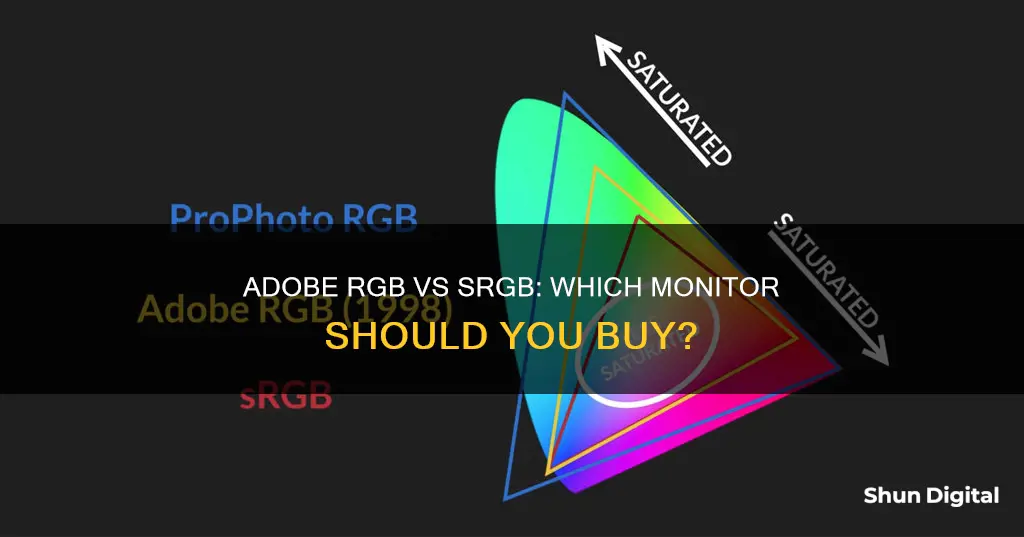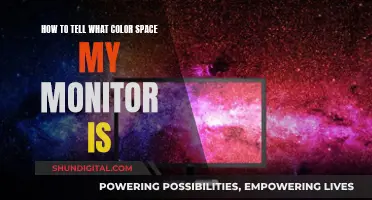
When it comes to choosing between an Adobe RGB or sRGB monitor, there are several factors to consider. Both options have their pros and cons, and the best choice depends on your specific needs and use case.
sRGB is the standard colour space for digital images, web, and printing. It was designed to standardise colour representation and perception on digital devices. sRGB is ideal for those who don't work in digital arts or have advanced colour needs. It is also the best option for those who want to ensure colour consistency across devices, as it is the standard colour profile for the web.
On the other hand, Adobe RGB offers a broader range of colours and is often preferred by professionals in digital arts and those with intricate colour management needs. It was designed to bridge the gap between RGB and CMYK colour models, improving the gamut range of sRGB.
If you are a photographer or work in visual media, you may find that each option has its advantages depending on the intended output of your work. For instance, if you primarily share your photos online, sRGB might be the better choice. However, if you plan on printing your photos, Adobe RGB could be more suitable.
Additionally, it is worth considering the potential added complexity and cost of Adobe RGB. It requires careful colour management and can be more challenging to work with. Adobe RGB monitors also tend to be more expensive.
In conclusion, the decision between an Adobe RGB or sRGB monitor depends on your specific requirements and intended use. sRGB is ideal for standard needs and web-based work, while Adobe RGB is better suited for advanced photography, printing, and those seeking a broader colour range.
| Characteristics | Values |
|---|---|
| Use case | sRGB is the standard for online use, while Adobe RGB is better for printing. |
| Colour accuracy | sRGB is more accurate for online use, while Adobe RGB is more accurate for printing. |
| Ease of use | sRGB is simpler to work with, while Adobe RGB requires additional software and a more complex workflow. |
| Cost | Monitors supporting Adobe RGB are more expensive than those supporting sRGB. |
| Compatibility | sRGB is compatible with most devices and software, while Adobe RGB requires colour-managed software and browsers. |
| Colour space | sRGB has a smaller colour space, while Adobe RGB has a larger colour space. |
What You'll Learn

Adobe RGB monitors are more expensive than sRGB monitors
Adobe RGB monitors are necessary if you want to match the colours on your monitor with the colours in a print. This is important in the pre-press environment and for soft proofing accuracy. They are also useful if you work in video production, CG, and animation fields, as they can display images according to industry standards such as DCI and BT.709.
However, sRGB monitors are more versatile and compatible with most standard cameras and printers. They are also the standard for web images and social media, so if you are uploading images to the internet, it is better to use an sRGB monitor.
Dual Monitor Setup: Consistent Image Sizing
You may want to see also

sRGB is the default colour space for the web
SRGB was developed by Hewlett-Packard and Microsoft in 1996. It was designed to complement the existing colour management strategies of the time by enabling a third method of handling colour in operating systems, device drivers, and the internet. This would be achieved by using a simple and robust device-independent colour definition.
The sRGB colour space is based on the RGB colour model, which utilises combinations of red, green, and blue lights to produce different colours or shades. sRGB is a subset of the RGB model and defines the range of colours that are available within its spectrum.
SRGB is ideal for sharing work online and in print, as well as for image editing and post-processing. It is well-suited for image editing because most software and devices default to sRGB. It is also ideal because it is the default colour space for most digital devices, including monitors, cameras, and printers.
Using sRGB ensures that your images appear consistent across various platforms, such as monitors, smartphones, tablets, and web browsers. It also guarantees that colours appear as intended, both online and in print.
However, it is important to be aware of sRGB's limitations. It has a smaller colour gamut compared to other colour spaces like Adobe RGB or ProPhoto RGB. This means that it provides fewer vibrant colours and may not cover the entire range of colours that can be perceived by the human eye.
Connecting Your Tablet to a Monitor: A Step-by-Step Guide
You may want to see also

Adobe RGB is designed for printing
Adobe RGB is a colour space that was developed by Adobe Systems, Inc. and introduced in 1998. It was designed to bridge the gap between the RGB and CMYK colour models, with the idea of encompassing most of the colours achievable with CMYK printers. CMYK, or Cyan, Magenta, Yellow, and Black, is the colour model used for colour printing. Adobe RGB is a larger colour space than sRGB, and is about 35% bigger.
Adobe RGB is ideal for advanced photography and printed works. It is often preferred by those who work in digital arts and have intricate colour management needs. It is more accurate but also more complicated to work with. If you are posting a picture online, it will be in sRGB. Always.
Adobe RGB is pretty much designed for printing. It is a more advanced colour space, and is often used by those who work in digital arts and have more complex colour management needs. It is ideal for those who want to produce a greater degree of colour accuracy for printed works.
Adobe RGB is a good choice if you are a professional photographer or work in publishing. It is also a good choice if you want to future-proof your monitor for high-quality printing. However, it is not necessary for those with more basic creative needs. If you are posting images online, they will be in sRGB, so it is important to remember to convert Adobe RGB images to sRGB before posting.
Turn Off Permission Usage Monitor Alerts for Good
You may want to see also

sRGB is ideal for those who don't work in digital arts
If you don't work in digital arts, sRGB is the ideal colour space for your monitor. sRGB, or Standard RGB, is the default option for most devices and has been since the mid-1990s. It was designed to be used for the World Wide Web, as well as with computer monitors and colour printers.
Today, sRGB remains the closest thing to a standard colour space. It is the most common colour space and is used by almost everything on a computer, including the internet, video games, applications, and personal devices.
Adobe RGB, on the other hand, is a more advanced colour space that was designed to be used in combination with Adobe Photoshop's range of complex colour features. It is often preferred by those who work in digital arts and have intricate colour management needs.
If you don't work in digital arts, the additional colours available in the Adobe RGB colour space are unnecessary. sRGB will provide a standardised experience in terms of how colours are represented and perceived on digital devices.
Additionally, if you are printing your work, you will need to save your images as sRGB for them to be displayed correctly on the web. While you can convert images from Adobe RGB to sRGB without any loss of colour, the reverse is not true.
Therefore, if you don't work in digital arts and are looking for a straightforward option that will guarantee your photos look great on the web and in print, sRGB is the ideal colour space for you.
Ultimate Guide: Choosing the Right Monitor
You may want to see also

Adobe RGB is more accurate but more complicated to work with
Adobe RGB is a more advanced colour space that offers a broader range of colours. It is often preferred by professionals in digital arts and photography who require intricate colour management. However, it requires a more complex workflow and can be more challenging to work with.
One of the biggest advantages of Adobe RGB is its ability to bridge the gap between the RGB and CMYK colour models. It improves the gamut range of sRGB, allowing for a more accurate representation of colours achievable through CMYK colour printing. This makes it ideal for advanced photography and printed works.
However, the downside of Adobe RGB is that it is not the standard colour space for the web. If you want to edit and upload photos to the internet, you may need to take additional steps to ensure consistent colour representation across different devices. This makes Adobe RGB more complicated to work with, as you have to carefully manage the conversion between colour spaces.
Moreover, not all printers and print labs can take full advantage of the Adobe RGB colour space. Some printing services assume that files are uploaded in sRGB, which can lead to unexpected results if you don't carefully manage the colour space conversion.
In summary, while Adobe RGB offers a more accurate and broader range of colours, it requires a more intricate workflow and colour management. It is important to consider your specific needs and whether the benefits of Adobe RGB outweigh the increased complexity.
Cox Data Usage: Monitor and Manage Your Data
You may want to see also
Frequently asked questions
Adobe RGB and sRGB are both colour spaces, or colour space profiles, that are commonly used within digital photography and visual media. sRGB is the standard colour space and is ideal for those who do not work in digital arts or have advanced needs. Adobe RGB, on the other hand, is often preferred by those who work in digital arts and require more intricate colour management.
An Adobe RGB monitor can display a broader range of colours, which is useful when producing a greater degree of colour accuracy for printed works.
Adobe RGB monitors are more expensive than sRGB monitors. They are also not the standard colour space profile for the web, so if you edit a photo in Adobe RGB and want to upload it to the internet, there may be additional steps required to ensure the colours are displayed correctly.







